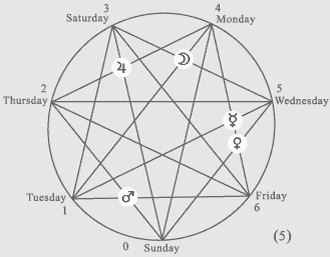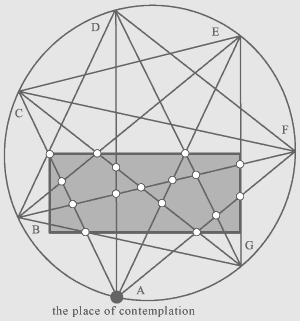Movement of stones of a Japanese garden within the framework of a heptagonal
network of lines allow to carry out complex games, and in essence complex logic
puzzles, which in some cases can be considered as calendar or mantic actions.
But also it is possible to carry out simple games and puzzles which have
elementary rules and do not demand logic decisions, but allow to change
arrangements of stones in a Japanese garden, namely allow to create varied
positions which result from movement of stones.
For example, it is possible to apply the following simple puzzle (patience).
Preliminary 35 stones have on 35 internal locuses of a heptagonal network of
lines, namely on everyone locuse have one stone. And also mix 28 tiles
(elements) of dominoes with combinations of figures from 0 up to 6. Then in the
casual order open tiles of dominoes, and delete outside of a heptagonal network
of lines and outside of a garden those stones which are on lines connecting
appropriate external locuses (points of contemplation). For example, if the
player has opened the tile of dominoes with figures 0 and 3 then deletes stones
from the line which connects the external locuse designated by figure 0 and the
external locuse designated by figure 3.
Look on the previous page the information about internal and external locuses,
and also about ratio of lines of a heptagonal network with figures of a
dominoes.
The puzzle is finished when 5 stones remained within a heptagonal network of
lines and within a garden. If there is other number of stones then the task of
a puzzle is considered unsolved.
The received arrangement of 5 stones can be considered as a position which can
exist during some period of time and can be changed as a result of the following
puzzle. For example, it is possible to carry out a puzzle on Sunday, and stones
of a garden can be motionless in other days of week.
And also it is possible to consider the received arrangement of stones as a
prediction if stones are compared to astrological planets, and external locuses
of a heptagonal network are compared to days of week. For example, the chart (5)
shows an arrangement of stones which means:
- planets Saturn and Sun have no values as stones-symbols of these planets are
absent;
- on Sunday there will be events (there will be conditions of consciousness)
which will matter on Thursday and will be caused by astrological value of the
planet Mars as the stone-symbol of Mars is located on the line which connects
points of contemplation compared with Sunday and Thursday;
- on Thursday there will be events which will be consequence of events on Sunday
and will be caused by astrological value of the planet Mars;
- on Sunday and Wednesday too there will be events which will be interconnected
and will be caused by astrological value of the planet Venus as the stone-symbol
of Venus is located on the line which connects points of contemplation compared
with Sunday and Wednesday;
- and also on Sunday and Saturday there will be interconnected events which will
be caused by astrological value of the planet Jupiter;
- on Monday and Friday there will be interconnected events which will be caused
by astrological values of two planets as stones-symbols of Mercury and Venus are
located on the line which connects points of contemplation compared to these
week days.
 |
Positions of stones on the chart are designated by
white circles and symbols of planets. For realization of a prediction it is necessary that among 35 stones was 5 stones-symbols compared with the planet Mercury, 5 stones-symbols compared with the planet Venus, 5 stones-symbols compared with the planet Mars, 5 stones-symbols compared with the planet Jupiter, 5 stones-symbols compared with the planet Saturn, 5 stones-symbols compared with the Sun and 5 stones-symbols compared with the Moon. Before the beginning of a puzzle it is necessary to mix stones and to arrange on 35 internal locuses of a heptagonal network of lines in the casual order. If mixing of stones cannot be executed then it is possible to solve a puzzle on a sheet of a paper and then to have stones of a garden according to the decision of a puzzle. |
It is possible to consider the received arrangement of stones not as a
prediction, but as a position (configuration) expedient for contemplation during
any certain period of time. If a puzzle is solved on Sunday and the arrangement
of stones is changed on Sunday then it is possible to perceive the received
arrangement as a position where stones-symbols of planets form a special figure
"conformable" to days of the next week.
It is possible to play various games and puzzle according to which it is
possible to have stones of a Japanese garden in a heptagon of lines and it is
possible to create configurations expedient for contemplation during the
different periods of time. The different quantity of stones can be involved in
various games and puzzle, and stones can be compared not only to astrological
planets but can have other symbolical values.
In this connection it is possible to assume that 15 stones in the garden of the
Japanese temple Ryoanji are a certain topological game or a topological riddle
in which stones have numerical values (values of numbers of Chinese numerology)
and the quantity of used stones is comparable to the sizes of the garden within
a heptagonal network of lines, that is shown on the following chart:
 |
The grey rectangular on the chart shows prospective
borders of the garden of stones in the Japanese temple Ryoanji before
reconstruction which was after a fire in 1789, that is the shown borders
differ from existing nowadays. Namely the right border of the garden is
compared to line EG and consequently has other position. White circles show locuses (points) in borders of a platform of the garden where stones can be located. As it is possible to see quantity of points is comparable with quantity of stones in the garden of temple Ryoanji that allows to assume about a certain game which was put in a basis of the garden Ryoanji, and was embodied as mathematical (numerological) and geometrical idea of the stones garden. Namely there are 15 stones and 16 locuses, and if one locuse is considered as "zero" then the task of game can consist in distribution of stones on 15 locuses, or in collecting stones in five locuses with three stones in everyone, or in any other moving stones. Concrete rules of game to me are not known, but stones can move according to a principle of Mancala Games (African Chess) or according to any other principles. Pay attention that 9 locuses are within a platform of the garden and 7 locuses coincide with borders of the garden, that too it is possible to take into account in rules of game. |
The following page shows charts according to which the quantity of points (locuses) in borders of a garden and within a heptagonal network of lines is comparable to quantity of letters in the Latin alphabet that allows to consider stones as symbols of letters, and allows to carry out games or puzzles in which words are formed.